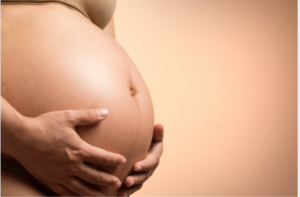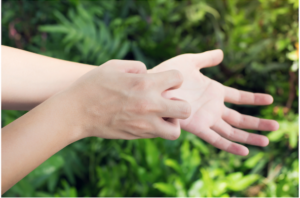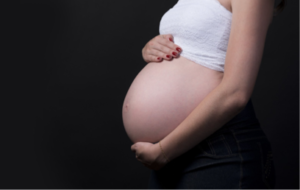Many women experience itching during their pregnancy. Although frustrating and uncomfortable, itching is a very common pregnancy related complaint and not usually a symptom to be concerned about.
However, itching can sometimes be a symptom of a liver condition that arises during pregnancy called Obstetric Cholestasis (or intrahepatic cholestasis of pregnancy). Obstetric cholestasis is a serious medical condition that requires monitoring by a healthcare professional throughout pregnancy.
This post will explore the different causes of itching during pregnancy and how to and when you should seek help.
We will also discuss what to expect (for you and your baby) if your pregnancy is affected by obstetric cholestasis.

What are the causes of itching in pregnancy?

(1) Itch associated with changes of pregnancy
Many women develop itching during pregnancy as the skin of the abdomen stretches to accommodate a growing bump. You might also develop itchiness due to the hormone changes associated with the progression of pregnancy. If itching is caused by natural pregnancy-related changes to the female body, it is usually mild to moderate in severity and not accompanied by a skin rash (1, 2).
Although itching during pregnancy can be very distressing, it should not cause any harm to you or your baby (1, 2). You do not usually need to see a healthcare professional for normal pregnancy-associated itching and we have included some tips below that you might find helpful in reducing your symptoms (1, 3):
⭐ Wear clothes that are loose, breathable and comfortable. It is best to avoid clothes made of synthetic materials or wool and instead opt for cotton or silk-based clothing.
⭐ Have cool baths and/or showers. Although bathing/showering with cool water might provide immediate relief from itching, it is best to avoid washing too frequently as this can dry out your skin. Try to keep baths/showers to under 20 minutes if possible and pat your skin dry after washing (avoid aggressively drying yourself off).
⭐ Use only non-perfumed soap and shower/bath products (emollient wash products are a gentle skin-friendly soap substitute).
⭐ Use lotion, moisturiser and/or emollient creams regularly and generously. It might also help to temporarily apply cold compresses and/or ice packs to particularly itchy areas.
⭐ It is best to keep your indoor environment, particularly the bedroom, cool. Some women find air humidifiers to be helpful.
⭐ Avoid consuming spicy foods, alcohol and/or caffeine.
⭐ Keep your nails short to minimise the damage to your skin from scratching. If you need to relieve itching, it is best to rub your skin rather than scratch.
If, however, you find that itching is significantly impacting your mental health or quality of life, you should make an appointment with your midwife or GP.
He/she can offer support and might be able to help you identify factors that are contributing to your symptoms and suggest ways for tackling the affect that itching is having on your pregnancy.

(2) Polymorphic Eruption of Pregnancy
Polymorphic eruption of pregnancy (PEP) is a relatively common skin condition that is estimated to occur in around 1 out of every 160 pregnancies (4). Most commonly, it affects women during their first pregnancy. PEP usually develops at the end of pregnancy (in the third trimester), although it can occasionally begin just after childbirth (5).
Also called ‘PUPPP’ or Pruritic Urticarial Papules and Plaques of Pregnancy.
Symptoms of PEP
Common symptoms of PEP include (5):
- Itching that often starts on the abdomen and commonly does not affect the belly button. If you have stretch marks, itching can begin within them.
- A rash that can be made up of welts (hives, such as those you get from stinging nettles), small raised lumps (papules) and/or large inflamed areas of red skin (plaques).
- This rash often spreads on the trunk, lower abdomen, under the breasts and the arms and/or legs.
- Areas of the body that are usually unaffected include the face, genitals, mouth and scalp.
- Small blisters can sometimes develop within the rash. If these are scratched, they can burst and leak straw-coloured fluid which can crust over.
If you develop many blisters, this might be a sign of a rare autoimmune pregnancy-associated skin condition called Pemphigoid Gestationis. The treatment needed for Pemphigoid Gestationis is different than that for PEP and will likely require ongoing monitoring from a dermatologist (5). It is always advisable to see your GP and/or maternity care team if you have any of the symptoms above for an accurate diagnosis and tailored treatment.

https://dermnetnz.org/topics/polymorphic-eruption-of-pregnancy/#:~:text=Polymorphic%20eruption%20of%20pregnancy%20is,Papules%20and%20Plaques%20of%20Pregnancy.
What causes PEP?
It is currently unclear why some women develop PEP and others do not. However, it is believed that stretching of the abdominal skin and hormonal changes during pregnancy play a significant role.
We also know that women carrying multiple babies (e.g. twins or triplets) appear to be more commonly affected by PEP (5).
Treatment Options
If you think that you might have PEP, you should make an appointment with your midwife and/or GP. If the diagnosis is unclear, or if your symptoms are not responding sufficiently to treatment, you can be referred to a dermatologist for specialist support. The goal of treatment will be to reduce both the itching and the inflammation of your skin caused by the PEP rash (5, 6).
The best treatment for you will depend largely on the severity of your symptoms, but is likely to include one of (or a combination of) the following (5, 6):
⭐ Self-help advice to relieve itching (see our tips above)
⭐ Topical emollient creams and/or ointments to soothe the skin
⭐ Topical steroid creams and/or ointments to reduce inflammation of the skin
⭐ Anti-histamine tablets which can relieve itching (always consult a healthcare professional before taking anti-histamines, to ensure you are using one that is suitable for pregnancy)
⭐ A short course of steroid tablets in severe cases of PEP (this will almost always need to be prescribed by a dermatologist)
What is the outlook for PEP?
Although PEP can be very unpleasant, most women respond well to treatment and achieve significant relief from their symptoms.
The condition is not harmful to you or your baby and should not impact your options for labour, delivery and/or breastfeeding. Most women find that PEP improves towards the end of their pregnancy or rapidly following childbirth.
Almost all cases of PEP resolve within a few weeks of delivery. PEP does not tend to reoccur in future pregnancies, except for pregnancies of multiple babies (5).


(3) Obstetric cholestasis
Obstetric cholestasis (also known as intrahepatic cholestasis of pregnancy) is an uncommon but serious liver disorder that can develop during pregnancy.
The condition causes bile acids and other harmful substances to build up in the liver, which can then “leak” into the bloodstream (6, 7). In the UK, around 7 out of 1000 pregnancies (less than 1%) are affected by obstetric cholestasis (7). The condition can begin at anytime during pregnancy, but symptoms most commonly develop after 28 weeks (6, 7).
Symptoms of obstetric cholestasis (6, 7)
⭐ The most common symptom of obstetric cholestasis is itching (in the absence of any skin rash).
- Itching tends to be most noticeable on the palms of your hands and soles of your feet. However, it can spread to anywhere on the body, including your arms and legs and, less frequently, your breasts, face and back.
- The itching is often worse at night, which can mean that you struggle to get a restful night’s sleep.
- The severity of itching can range from mild to intense. However, more intense itching does not mean that you have a more severe form of the condition.
- Although there is usually no rash, women can sometimes scratch so vigorously that the skin can become red, inflamed and/or broken.

Less common symptoms include:
⭐ Dark coloured urine
⭐ Pale coloured bowel movements
⭐ Yellowing of the skin and/or whites of the eyes (jaundice)
⭐ Loss of appetite
⭐ Tiredness
⭐ Pain around the liver (this might be felt just under the ribs on the right side of your abdomen or, less commonly, radiating to your back under your right shoulder)
What causes obstetric cholestasis?
The cause of obstetric cholestasis is currently unclear, although it is believed that hormones, environment and genetics might play a role in its development.
Hormones
Higher levels of the female hormones during pregnancy, including oestrogen and progesterone, are thought to affect the functioning of the liver, which might contribute to the development of obstetric cholestasis (6, 7).
Genetics
Obstetric cholestasis is more common in women of certain ethnic backgrounds, including Indian and Pakistani (where approximately 1.5% of pregnancies are affected).
It also seems that obstetric cholestasis runs in families (7).
Environment
It appears that obstetric cholestasis is more common in the winter time, which leads us to believe that dietary factors (e.g. low levels of Vitamin D) might be involved (6).
How will I be diagnosed with obstetric cholestasis?
It is very important that you make an urgent appointment with your maternity care team (e.g. obstetrician or midwife) if you have any of the symptoms listed above.
However, do not forget that itching is a very common symptom of pregnancy. Only a small number of pregnant women with itching (even severe or persistent itching) will be diagnosed with obstetric cholestasis (6, 7).
Assessment for obstetric cholestasis is likely to include (6-8):
- An inspection of your skin, to assess for other causes of itching during pregnancy (e.g. PEP or eczema).
- A range of blood tests, including: liver function tests (which help gauge how the liver is working); bile acid test (to measure the amount of bile acids in your bloodstream); and/or additional screening bloods to help rule out other causes of liver problems.
- An ultrasound scan of your liver to check for any abnormalities or gallstones.
- A well-being check of your baby.
If your blood tests are normal but your itching does not improve, you will have to have them repeated. This is because there can be a delay between the onset of symptoms and the changes to your blood tests that confirm a diagnosis of obstetric cholestasis (6,7).
What does obstetric cholestasis mean for my baby?
The definitive impact of obstetric cholestasis on babies is not completely clear (7). However, there is evidence that the condition can affect babies in the following ways (6, 7, 9):
- Premature birth
Women with obstetric cholestasis have an increased risk of their child being born prematurely. Around 1 in 10 women with the condition give birth before 37 weeks of pregnancy (however, this figure includes women who have had their labour induced because of obstetric cholestasis) (7).
The evidence suggests that spontaneous premature labour (without being induced) occurs in around 4-10% of pregnancies with obstetric cholestasis (6).
- Stillbirth
Small research studies from many years ago suggested that the risk of stillbirth was higher among women diagnosed with obstetric cholestasis. However, more recent studies have demonstrated a similar risk of stillbirth (around 1 out of every 200 pregnancies) among women with and without obstetric cholestasis.
It is unclear whether these more promising statistics are the result of improvements in maternity care, overall improvements in women’s health and/or early induction of labour in women with obstetric cholestasis (7, 9).
- Meconium
Babies of women with obstetric cholestasis are more likely to pass meconium (first bowel movement) during pregnancy or labour. The early passing of meconium can cause breathing difficulties for your baby, which might mean he/she is more likely to need treatment in a neonatal unit (6, 7, 9).
What does obstetric cholestasis mean for me?
Obstetric cholestasis will not have any serious or lasting consequences for your health (7). However, it can be extremely distressing, and some women find that the condition significantly affects their mental health and wellbeing during pregnancy.
Feeling overwhelmed, anxious and/or low in mood are not uncommon for women struggling with obstetric cholestasis, and you are not alone. It is important to discuss the impact that obstetric cholestasis is having on your quality of life and mental health with a healthcare professional (e.g. your GP, midwife or obstetrician), who can provide ongoing support.
Some women find counseling (such as talking therapies) helpful, and this is something that your midwife or doctor can refer you for if appropriate (6).
ICP Support is an excellent organisation that offers one-on-one and group support to women suffering from obstetric cholestasis via telephone, text and video Zoom meetings; they also offer a range of helpful forums and friendly Facebook groups for affected women. Information on all of the services they provide and contact numbers are available here.
Will I need extra care during pregnancy?
If you are diagnosed with obstetric cholestasis, your maternity care will be under a consultant obstetrician. You will need to deliver your baby in a consultant-led maternity unit in a hospital that also has a specialist neonatal unit.
It is likely that your consultant will arrange for you to have additional antenatal appointments to closely monitor baby’s well-being (e.g. more frequent ultrasound scans to assess baby’s growth and the amount of amniotic fluid around baby).
You will also need to have regular blood tests to assess your liver function (usually once or twice a week), until your baby is born (6, 7, 9).
What does this mean for labour and delivery?
Your consultant may recommend that you undergo an induction of labour after 37 weeks of pregnancy (6-9) . This will largely depend on the degree of abnormality of your blood results (e.g. how high your bile acids are), severity of your symptoms and well-being of your baby (6, 9).
The decision about whether or not induction is right for you will involve balancing the risks of induction (e.g. failed induction, increased likelihood of needing a C-section or instrumental delivery) with the uncertain risk of continuing the pregnancy beyond 37 weeks (possibility of stillbirth) (9).
Unfortunately, the individual risk of stillbirth associated with continuing a pregnancy is impossible to predict. However, your obstetrician will always discuss with you the best and safest management options for your individual circumstance, so that you can make an informed decision about all aspects of your delivery (6, 7).
Treatment Options
The only cure for obstetric cholestasis is to give birth to your baby. The aim of treatment will be to reduce the severity of your symptoms. There is not currently definitive evidence to suggest that any of the available treatment options affect the outcome for your baby (7-9).
Recommended treatment is likely to include a combination of the following (7-9):
⭐ Self-help advice to relieve itching (see our tips above).
⭐ Topical creams and/or ointments to soothe the skin and temporarily reduce itching.
⭐ Drowsiness-causing anti-histamine tablets that may help you sleep at night.
⭐ A medication called Ursodeoxycholic acid (or “Urso”) which can reduce the amount of bile acids in your bloodstream, improve liver function and reduce itching. Unfortunately, there is not currently enough evidence on the use of Urso in pregnancy to determine whether it protects against stillbirth or is completely safe for unborn babies.
⭐ Vitamin K is often prescribed for mothers whose blood clotting mechanism is affected by obstetric cholestasis. For these women, taking daily Vitamin K will help prevent complications if they start to bleed. Evidence suggests that there might be a small benefit to taking Vitamin K even if your blood clotting is unaffected. Your consultant can discuss the pros and cons of taking Vitamin K with you to help you make an informed choice.
Will I need follow-up after childbirth?
Obstetric cholestasis will get better after you give birth to your baby. However, you should have a follow-up appointment to have your blood tests repeated to check that your liver function is returning to normal.
If your symptoms do not resolve after childbirth, or your blood tests do not normalise, this might point towards a diagnosis other than obstetric cholestasis. Women in this situation will be referred to a specialist (e.g. liver consultant) for further assessment and ongoing support (7-9).
Outlook
Obstetric cholestasis should not cause any long-term health consequences for you or your baby. However, there is a high risk of recurrence of the condition in future pregnancies.
It is estimated that between 45-90% of women who develop obstetric cholestasis will get the condition again in subsequent pregnancies (7, 9).
There is also evidence that obstetric cholestasis runs in families (e.g. if you have been affected with the condition, it is likely that other women in your family will develop it as well). However, the exact statistics regarding the risk to family members of developing obstetric cholestasis if a relative of theirs has been affected are unclear (7-9).
The RCOG advises that women affected by obstetric cholestasis avoid oestrogen-containing contraceptives, such as the combined oral contraceptive pill (7, 9). Women in this situation can discuss alternative contraception options with their GP if necessary.


Conclusion
The majority of women who develop itching during pregnancy will have uncomplicated itching associated with normal pregnancy-related changes to the female body (1, 2). Women in this situation can often manage their symptoms at home with self-help remedies.
If, however, your itching is severe, significantly affecting your quality of life and/or you develop any of the symptoms suggestive of obstetric cholestasis (see above), it is crucial that you see a healthcare professional promptly. Only a small number of women who are assessed for obstetric cholestasis will ultimately be diagnosed with the condition (6, 7).
Obstetric cholestasis is a serious and distressing condition and affected women will require monitoring and support throughout their pregnancy. The symptomatic relief achieved with treatment will vary from woman to woman, but your obstetrician should be able to continually recommend the best treatment options for your individual situation (6-9).
Despite the gravity of an obstetric cholestasis diagnosis, it is important to remember that, with appropriate monitoring and treatment, most women with the condition give birth to healthy babies (6).
References
(1) Itching in Pregnancy. Tommy’s. Published: September 2018. https://www.tommys.org/pregnancy-information/symptom-checker/itching-pregnancy?gclid=Cj0KCQjwk8b7BRCaARIsAARRTL5IOXbamfX4JquSV Gwn6Th35g-Nz89GSxAOV-vSOXJg8XY1u8M_2Y8aAqo3EALw_wcB
(2) Itching and Intrahepatic Cholestasis of Pregnancy. NHS. Published: August 2019. https://www.nhs.uk/conditions/pregnancy-and-baby/itching-obstetric-cholestasis-pregnant/
(3) Itch in Pregnancy. Scenario: Management of Itch with Rash in Pregnancy. National Institute for Health and Care Excellence. Published: April 2020. https://cks.nice.org.uk/topics/itch-in-pregnancy/ management/itch-with-rash/#self-care-advice
(4) Polymorphic Eruption of Pregnancy (PEP). GP Notebook. Published: January 2018. https://gpnotebook.com/simplepage.cfm?ID=-402259902
(5) Polymorphic Eruption of Pregnancy. British Association of Dermatologists. Published: January 2006. Last reviewed: March 2018. https://www.bad.org.uk/for-the-public/patient-information-leaflets/polymorphic-eruption-of-pregnancy/?showmore=1&returnlink=https%3A%2F%2Fwww.bad.org.uk%2Fpatient-information-leaflets#.X3Hrri05TK0
(6) Intrahepatic Cholestasis of Pregnancy (ICP). Tommy’s. Published: October 2017. https://www.tommys.org/pregnancy/complications/obstetric-cholestasis
(7) Obstetric Cholestasis. Royal College of Obstetricians and Gynaecologists. Published: May 2012. https://www.rcog.org.uk/globalassets/documents/ patients/patient-information-leaflets/pregnancy/pi-obstetric-cholestasis.pdf
(8) Itch in Pregnancy. Scenario: Management of Itch in Pregnancy Without Rash. National Institute for Health and Care Excellence. Published: April 2020. https://cks.nice.org.uk/topics/itch-in-pregnancy/management/itch-without-rash/
(9) Obstetric Cholestasis. Green-top Guideline No. 43. Royal College of Obstetricians and Gynaecologists. Published: April 2011. https://www.rcog.org.uk/globalassets/documents/guidelines/gtg_43.pdf
